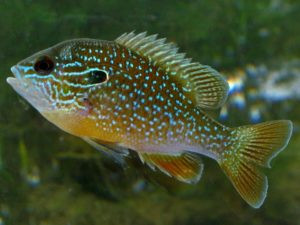Trying to catch panfish in the spring is overlooked by many anglers. Anglers tend to focus on trout, pre-spawn bass, and muskies in the majority of instances. Fishing for the preferred species is fine. But, a day going for panfish can be more enjoyable due to the aggressive nature of most panfish. The number of bluegills and crappies makes them easier targets. Also, panfish go through the same routine in spawning as the other species.

The only difference is the length of the pre-spawn periods. Bluegill and many other panfish spawn in late spring or early summer. As a result, they have longer pre-spawn periods. The pre-spawn is when fish are feeding heavily after the winter. Panfish will be in a feeding frenzy during the time to put on weight. This is part of preparing for the spawn. An angler needs to know where to find the fish and when to fish.
Where to Catch Panfish in Spring
The ice has broken up and melted away, days are getting longer, and the water is warming. This jump-starts the life cycle in water. All the little creatures fish feed on become plentiful. This includes panfish becoming more active. On warm sunny days, they will inhabit the shallows in search of small insects and minnows. When the temperature drops the fish will move out to deeper water. They do not move far unless the cold spell is long. Use the weather as an advantage.
Use waders or fish from the shore on warmer days. The fish are close and often in 1-3 feet of water making use of a boat difficult. The brush piles and any other cover present will be packed with fish. In the earlier spring, weeds may not have come up so focus on the other cover. If weeds are present check them out also. Fishing in spring you will catch panfish in big numbers in the right spot.
If the weather turns colder, get in the boat, and head out to deeper water. The fish will go into the stable water that is deeper. Fluctuations in water temperatures stress all fish. The fish will avoid stress by going to stable water temperature areas of the body of water. Once the fish are found use smaller baits since they tend to be finicky in colder conditions. Finding the fish may be easy or tough depending on how well you know the waters.
Tackle to Catch Panfish
An ultra-lite or light action rod is preferable but a medium action will do if it is all you have available. The lighter rods and lines result in more bites and a better fight. Using a rod too strong will take the joy out of fishing since the panfish will be overpowered on heavier tackle. Line 2-6 pound test is the best and only use other lines if you have no choice. Heavier lines are noticed by the fish by seeing the line or feeling the tension.
The size of the panfish determines the hook size but sizes 8-12 are commonly used. Aberdeen or baitholder hooks are fine to catch panfish. The Aberdeen hook is easier to remove, although baitholder hooks hold worms better. Choose the hook based on bait when using live bait. The other option is using jigs. Small hair jigs or jigs with small grubs 1/32 to 1/8 ounce work best. Sometimes they perform better than live baits. Color is dependent on water variables such as clarity, depth, and generally what prey is present.
Suspend the bait off the bottom with a bobber. Panfish will suspend during warmer weather and not be at the bottom. In the cooler weather, the bottom may be where they are located. Regardless, look for them to suspend most of the time, however, around structure and cover. All fish behave based on the species. Panfish are not an exception. Learning about the habitat, behavior, and other information will help catch more panfish.
Conclusion
Panfish are good to eat and easy to catch. Take some time to enjoy the bounty of America’s widespread population of panfish. Found from Canada to Mexico in various subspecies they are easy to find. As a result, a family can all enjoy the benefits of being outside for a day. Children find fishing for panfish more fun than sitting around waiting for bites also.
Keeping fishing simple for tight lines and bragging rights
John McIntyre
